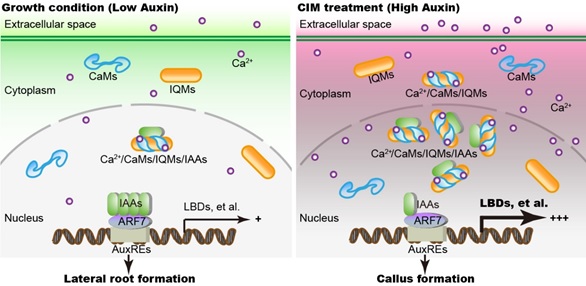Plant somatic cells retain high totipotency, which confers plants with a high regeneration capability in vivo or under appropriate culture condition. A typical plant in vitro regeneration system often starts with the induction of pluripotent cell mass termed callus from detached organs or tissues on a auxin-rich medium, and auxin-induced callus formation has long been considered to be cellular reprogramming for acquisition of regeneration capability. However, other signals governing callus formation and thus regeneration capability remains largely elusive.
A research team led by Prof. HU Yuxin from the Institute of Botany of the Chinese Academy of Sciences revealed that the Arabidopsis calcium signaling module CALMODULIN IQ-MOTIF CONTAINING PROTEIN (CaM-IQM) plays an important role in governing callus and lateral root formation by interplaying with auxin signaling.
The article entitled “The calcium signaling module CaM-IQM destabilizes IAA-ARF interaction to regulate callus and lateral root formation” was published online in PNAS on June 28.
Researchers showed that disruption of IQMs or CaMs retards auxin-induced callus and lateral root formation by dampening auxin responsiveness. They demonstrated that CaM-IQM complexes physically interact with the auxin signaling repressors INDOLE-3-ACETIC ACID INDUCIBLE (IAA) proteins in a calcium-dependent manner.
Furthermore, researchers found that the physical interaction of CaM6 with IAA19 destabilizes the repressive interaction of IAA19 with AUXIN RESPONSE FACTOR 7 (ARF7) and thus promotes auxin-induced callus and lateral root formation.
Calcium is a universal signal in eukaryotic cells that regulates multiple cellular and developmental events, and all the basal media used in plant in vitro regeneration system contain a high level of calcium. However, the molecular link of calcium signaling and auxin actions in plants has been considered to be missing.
“Therefore, these findings not only define the calcium signaling module CaM-IQM as an important regulator of callus and lateral root formation, but also disclose a molecular interplay between calcium signaling and auxin actions during plant regeneration and development,” said HU Yuxin, corresponding author of the study.
The work was supported by the National Natural Science Foundation of China and the Strategic Priority Research Program of Chinese Academy of Sciences.

A proposed model for CaM-IQM-mediated Ca2+ signaling during lateral root (left) and callus (right) formation. (Image by IBCAS)
Articles link: https://doi.org/10.1073/pnas.2202669119
Contact:
Prof. Yuxin Hu
Key Laboratory of Plant Molecular Physiology, CAS
Institute of Botany, Chinese Academy of Sciences,
20 Nanxincun, Xiangshan, Beijing 100093, China
E-mail: huyuxin@ibcas.ac.cn
Plant somatic cells retain high totipotency, which confers plants with a high regeneration capability in vivo or under appropriate culture condition. A typical plant in vitro regeneration system often starts with the induction of pluripotent cell mass termed callus from detached organs or tissues on a auxin-rich medium, and auxin-induced callus formation has long been considered to be cellular reprogramming for acquisition of regeneration capability. However, other signals governing callus formation and thus regeneration capability remains largely elusive.
A research team led by Prof. HU Yuxin from the Institute of Botany of the Chinese Academy of Sciences revealed that the Arabidopsis calcium signaling module CALMODULIN IQ-MOTIF CONTAINING PROTEIN (CaM-IQM) plays an important role in governing callus and lateral root formation by interplaying with auxin signaling.
The article entitled “The calcium signaling module CaM-IQM destabilizes IAA-ARF interaction to regulate callus and lateral root formation” was published online in PNAS on June 28.
Researchers showed that disruption of IQMs or CaMs retards auxin-induced callus and lateral root formation by dampening auxin responsiveness. They demonstrated that CaM-IQM complexes physically interact with the auxin signaling repressors INDOLE-3-ACETIC ACID INDUCIBLE (IAA) proteins in a calcium-dependent manner.
Furthermore, researchers found that the physical interaction of CaM6 with IAA19 destabilizes the repressive interaction of IAA19 with AUXIN RESPONSE FACTOR 7 (ARF7) and thus promotes auxin-induced callus and lateral root formation.
Calcium is a universal signal in eukaryotic cells that regulates multiple cellular and developmental events, and all the basal media used in plant in vitro regeneration system contain a high level of calcium. However, the molecular link of calcium signaling and auxin actions in plants has been considered to be missing.
“Therefore, these findings not only define the calcium signaling module CaM-IQM as an important regulator of callus and lateral root formation, but also disclose a molecular interplay between calcium signaling and auxin actions during plant regeneration and development,” said HU Yuxin, corresponding author of the study.
The work was supported by the National Natural Science Foundation of China and the Strategic Priority Research Program of Chinese Academy of Sciences.

A proposed model for CaM-IQM-mediated Ca2+ signaling during lateral root (left) and callus (right) formation. (Image by IBCAS)
Articles link: https://doi.org/10.1073/pnas.2202669119
Contact:
Prof. Yuxin Hu
Key Laboratory of Plant Molecular Physiology, CAS
Institute of Botany, Chinese Academy of Sciences,
20 Nanxincun, Xiangshan, Beijing 100093, China
E-mail: huyuxin@ibcas.ac.cn
